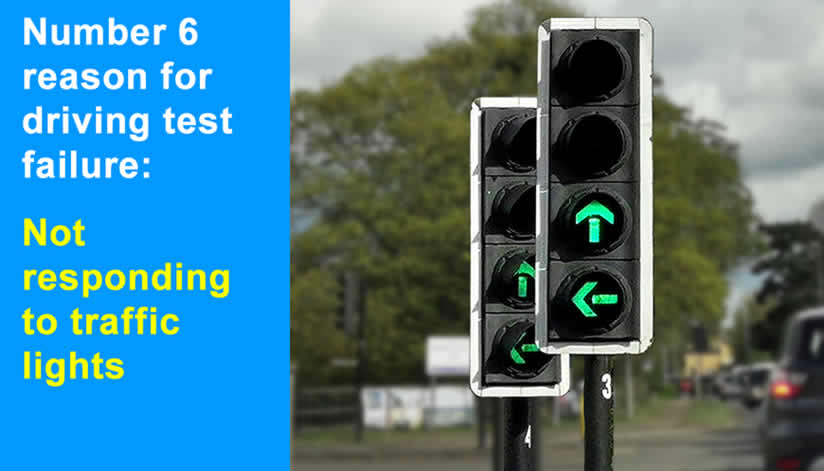Many traffic accidents occur each year due to drivers disobeying traffic lights. Therefore, it’s reasonable to understand why examiners strict on test candidates who make mistakes at traffic lights.
Not responding appropriately to traffic lights accounts for many test failures and comes in at number 6 in the official DVSA‘s top 10 reasons for driving test fails. Faults made at traffic lights, whether a (minor) fault, serious or dangerous fault will be marked under the ‘Response to signs – Traffic lights’ section on the driving test report.
Going Through a Red Light
This fault is quite self-explanatory and involves the test candidate proceeding through the junction, even though a red light is clearly showing.
This fault typically occurs, not as a blatant disregard of traffic lights, but as a last second decision to continue just as the lights change to red. The key to dealing with traffic lights is to assess them in good time, well before you reach them. If the lights have been green for a good amount of time, you can anticipate that they’re likely to change just as you reach them.
As you approach them, you can then reduce your speed a little and be prepared to stop, just before the stop line. Remember that if the lights change to amber, you should stop, unless it’s not safe to do so. This mean that if the lights turn amber, only continue if you have already crossed the stop line, or if you’re already so close to the stop line that it will be dangerous for following vehicles if you stopped.
If you happen to find yourself in the situation where you’re moving slowly and the front of your vehicle has already crossed the stop line and then the lights turn red, you should still stop and wait for the lights to change to green. However, this situation should really not arise as you should have been prepared to stop at amber.
Advanced Stop Lines
Some signal controlled junctions have a box area, just prior to the traffic lights. The box is usually marked by a solid white boundary and has a white image of a bicycle inside it. These areas are called advanced stop lines and are special areas for cyclists to filter ahead of queuing traffic and to remain safe, inside the box.
This fault occurs when the test candidate stops ahead of the first stop line, within the area for cyclists. As with any signal controlled junction, try to anticipate what the lights will do before you reach them and if the lights are likely to change to amber/red as you approach, prepare to stop just before the first stop line.
However, if your vehicle has already traveled over the first stop line and the lights change to red, you must stop at the second line. This will still fail a driving test, but it’s essential that you do not continue through the junction on a red light.
Blocking the Junction When Turning Right
At a light controlled junction, the test candidate is turning right. The test candidate pulls forward and waits in the middle of the junction for approaching traffic to clear. When the repeater light turns red and the approaching traffic stops, the test candidate remains in the junction, blocking it.
A repeater light is a secondary light set a little further along from the first light that allows a driver to clearly see the lights, even when waiting at the stop line. The repeater/secondary light is also observable for drivers who have passed the stop line and are waiting in the middle of the junction to turn right.
This can cause confusion for the test candidate as they think the red light means they cannot proceed. However, the test candidate should use this opportunity to continue and exit the junction to prevent blocking it.
Remaining Stationary When the Light is Green
This fault occurs when the test candidate is waiting at a light controlled junction, the light changes to green, but the test candidate fails to proceed when the junction is clear. This can be due to the test candidate not being sure which light applies to them or that they are not paying attention.
Proceeding at a Green Light but the Junction is Not Clear
In this situation, the test candidate goes ahead when the traffic light turns green, but the junction is not clear of traffic. This means that the test candidate’s car will block the junction when the traffic lights change.
It’s important to always check that your exit road is clear before proceeding into a junction, even if your light is green. If your exit is not clear, continue to wait at the lights until it is, even if that means waiting for the next green light.
